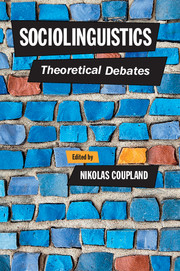Book contents
- Frontmatter
- Contents
- List of contributors
- Preface and acknowledgements
- 1 Introduction: Sociolinguistic theory and the practice of sociolinguistics
- Part I Theorising social meaning
- Part II Language, markets and materiality
- Part III Sociolinguistics, place and mobility
- Part IV Power, mediation and critical sociolinguistics
- Part V Sociolinguistics, contexts and impact
- Part VI The evolution of sociolinguistic theory
- 18 Succeeding waves: Seeking sociolinguistic theory for the twenty-first century
- 19 Language theory in contemporary sociolinguistics: Beyond Dell Hymes?
- 20 Five Ms for sociolinguistic change
- Index
- References
20 - Five Ms for sociolinguistic change
from Part VI - The evolution of sociolinguistic theory
Published online by Cambridge University Press: 05 June 2016
- Frontmatter
- Contents
- List of contributors
- Preface and acknowledgements
- 1 Introduction: Sociolinguistic theory and the practice of sociolinguistics
- Part I Theorising social meaning
- Part II Language, markets and materiality
- Part III Sociolinguistics, place and mobility
- Part IV Power, mediation and critical sociolinguistics
- Part V Sociolinguistics, contexts and impact
- Part VI The evolution of sociolinguistic theory
- 18 Succeeding waves: Seeking sociolinguistic theory for the twenty-first century
- 19 Language theory in contemporary sociolinguistics: Beyond Dell Hymes?
- 20 Five Ms for sociolinguistic change
- Index
- References
Summary
Sociolinguistic change
In a few earlier publications I have lobbied for sociolinguists to begin working with a conception of sociolinguistic change (Coupland 2009; 2014a,c). Androutsopoulos (2014a) uses this concept in titling his comprehensive volume, Mediatization and Sociolinguistic Change, and in his introduction to that book (2014b) he points out that the phrase has been in fitful circulation for some years with a range of different meanings. To my mind the idea of sociolinguistic change is both liberating and focusing for sociolinguistics. It liberates the field to look beyond ‘language change’, which has set its sights on highly constrained sorts of change. The idea of sociolinguistic change focuses sociolinguistics by requiring it to be specific about what other sorts of change are then in question (principally in relation to what is generally called social change). In other words, theorising sociolinguistic change will entail reconsidering what priorities sociolinguistics should have in connection with change, why, and with what implications.
The present chapter firstly (in the rest of this section) extends this view of sociolinguistic change, vis-à-vis language change and social change; sociolinguistic change is broadly defined as consequential change over time in language–society relations. Then, in later sections, several of the main themes that have emerged in the earlier chapters of this book are reconsidered – all of them explicitly relevant to sociolinguistic change in this sense and able to contribute to the further theorising of this concept. The five themes, or thematic clusters, can be referred to (without undue artificiality) by five ‘m’-led keywords: markets, mobility, modalities, media, and metacommunication. Overlaps between this list and earlier sections and chapters of this book are, therefore, easily visible. It is unlikely that the whole of what we should call sociolinguistic change can ultimately be contained within changes in these five thematic dimensions. On the other hand, separately and together, they account for a substantial part of the changes in language–society relations that have already been debated in earlier chapters.
My brief comments on social theory in Chapter 1 pointed to ambiguity in the use of this term, but also to repeated efforts in the social sciences to establish, in broad theoretical terms, how a given society stands in its historical trajectory, from different critical standpoints.
- Type
- Chapter
- Information
- SociolinguisticsTheoretical Debates, pp. 433 - 454Publisher: Cambridge University PressPrint publication year: 2016
References
- 15
- Cited by



